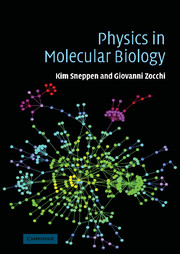Book contents
- Frontmatter
- Contents
- Preface
- Introduction
- 1 What is special about living matter?
- 2 Polymer physics
- 3 DNA and RNA
- 4 Protein structure
- 5 Protein folding
- 6 Protein in action: molecular motors
- 7 Physics of genetic regulation: the λ-phage in E. coli
- 8 Molecular networks
- 9 Evolution
- Appendix Concepts from statistical mechanics and damped dynamics
- Glossary
- Index
6 - Protein in action: molecular motors
Published online by Cambridge University Press: 06 July 2010
- Frontmatter
- Contents
- Preface
- Introduction
- 1 What is special about living matter?
- 2 Polymer physics
- 3 DNA and RNA
- 4 Protein structure
- 5 Protein folding
- 6 Protein in action: molecular motors
- 7 Physics of genetic regulation: the λ-phage in E. coli
- 8 Molecular networks
- 9 Evolution
- Appendix Concepts from statistical mechanics and damped dynamics
- Glossary
- Index
Summary
Molecular motors: energy from ATP
Proteins can be grouped into a few broad categories with respect to their function. Some are regulatory, some are enzymes, some are structural, and some proteins do mechanical work. It is this latter group that we now discuss. Molecular motors include kinesin, myosin, dynein, the motors connected to DNA replication, to gene transcription and to translation. The motors are mostly driven by ATP hydrolysis: ATP → ADP + P, a process with ΔG ≈ 13 kcal/mol for typical conditions in the cell. Exactly how the free energy difference from ATP hydrolysis is converted into directed motion and mechanical work is a most interesting question, which is not resolved. In many cases the conformational changes of the protein are known in considerable detail from structural studies. The sequence of events associating conformational changes and substrate binding and release is also known. Nonetheless, the actual physical mechanism by which the motor works is not obvious. Thermal noise and diffusion certainly play a role, making this “soft” machine qualitatively different from a macroscopic motor. In the next section we elaborate on these ideas through some models.
The most studied motors include myosin and kinesin, which move along the polymers that define the cytoskeleton. Kinesin walks on microtubules (Fig. 6.1), whereas myosin walks on polymerized actin. Microtubules and actin fibers are long (μm) polymers where the monomer units are proteins. Microtubules are very stiff; actin fibers more flexible. Kinesin motors work independently of each other, and are associated with the transport of material (vesicles) inside the eukaryotic cell.
- Type
- Chapter
- Information
- Physics in Molecular Biology , pp. 127 - 145Publisher: Cambridge University PressPrint publication year: 2005



